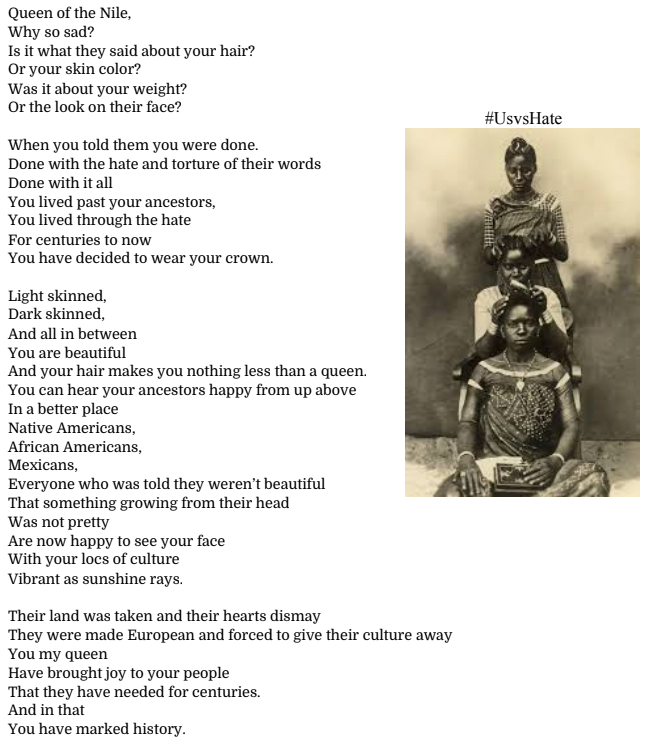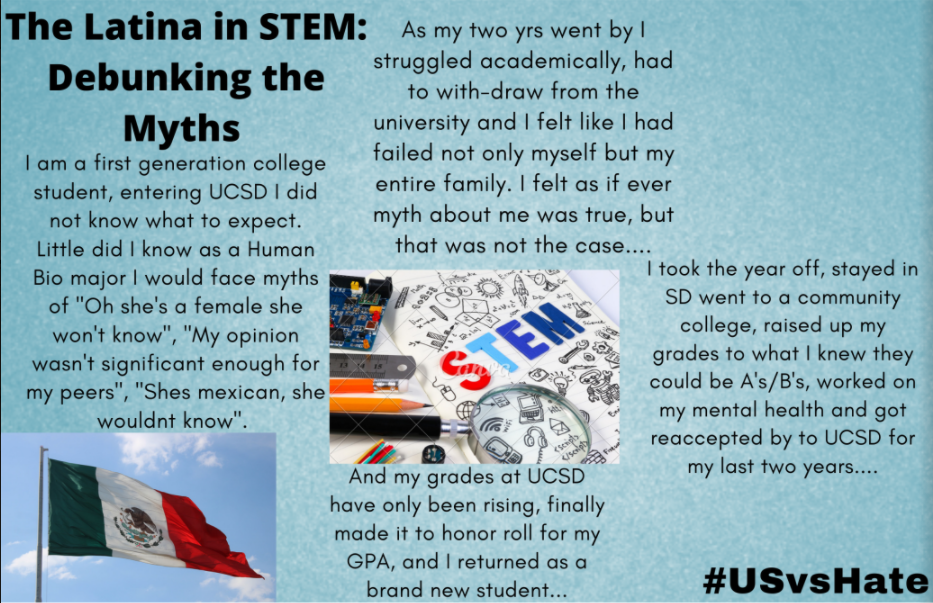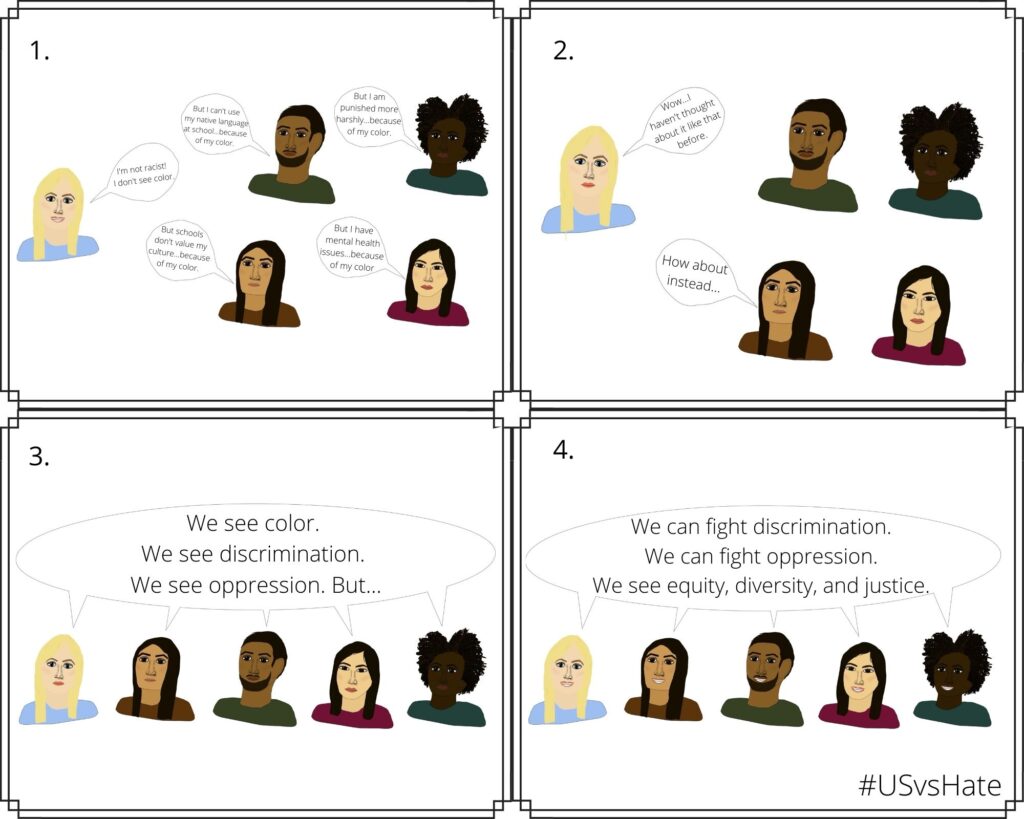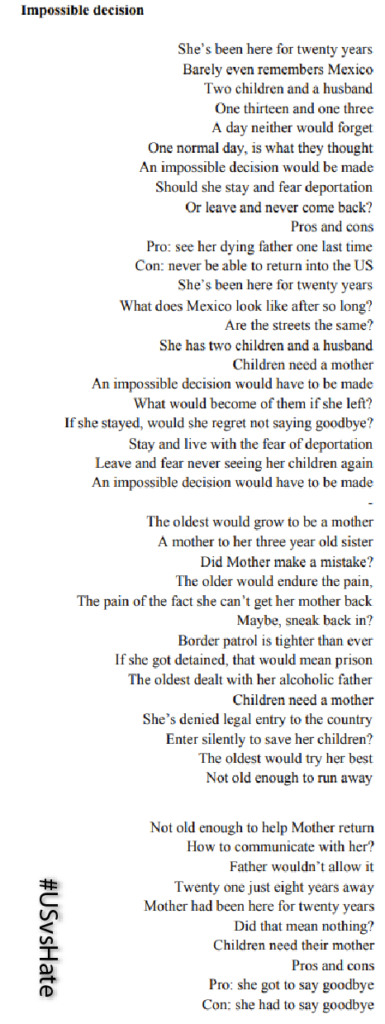Rudy, Grade 2, Poway, CA
See below video for student backstory.
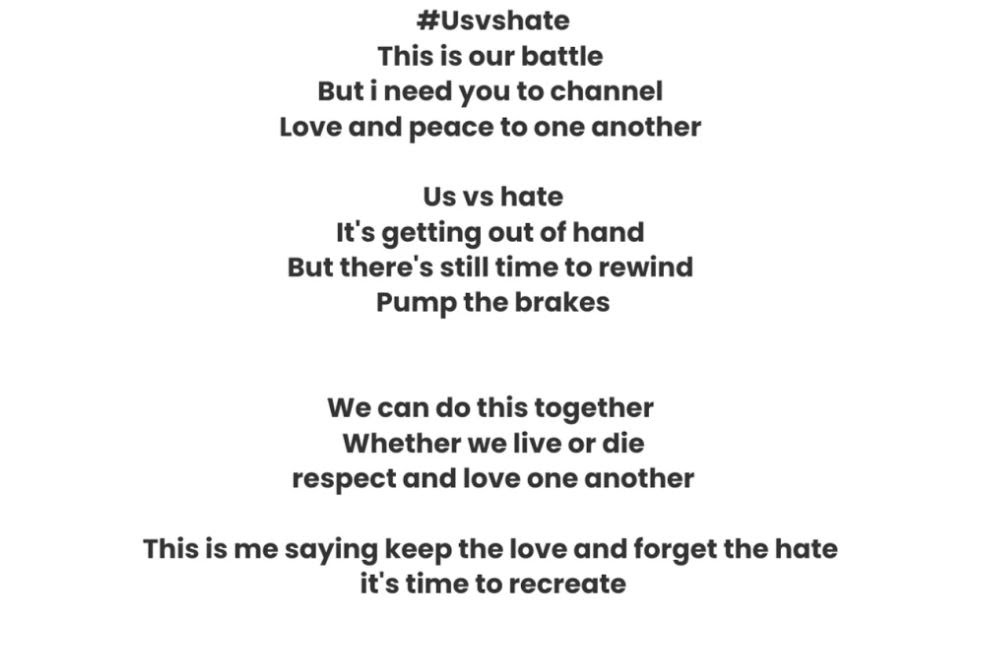
Jerlene, Grade 8, National City, CA
Jerlene enjoys making edits and felt driven to create a message that empowers people to stand strong in their support of people of all backgrounds and identities.
Ella, Grade 9, San Diego, CA
Click HERE for student anti-hate message
Anonymous, Grade 9, San Diego, CA
This student’s teacher explains, “This year, I created my own unit around the graphic novel March by John Lewis. Students participated in a virtual privilege walk, a lunch counter protest gallery walk, in-class and independent readings of the graphic novel, and discussion boards centered around concepts and issues that were brought up in the narrative. To close the unit, students were asked to create their own message as a way of honoring John Lewis’s courageous work.”
Valeria, Grade 10, El Segundo, CA
Valeria explains, “For this Anti-hate poster, I was inspired by the idea of equality and that everybody should be equal no matter what. I split the person into three different faces and skin colors to represent people of different backgrounds and I used a quote by a women’s rights activist named Alice Paul because I felt that it resonated with what I was trying to say. I think a good anti-hate poster is visually appealing and gives a short message that sticks with someone, which is why I chose to make it colorful and happy- looking to the viewers, along with the short quote said by an amazing woman. Overall, I just wanted to bring a joyful aspect to equality and inclusion of people!”
Paloma, Grade 10, El Segundo, CA
Paloma explains, “I came up with this idea after watching a 2020 presidential debate and becoming extremely frustrated listening to two men argue about a woman’s right to an abortion. I believe that a woman has a right to choose what happens to her body, and not only should she get to choose, it shouldn’t be a topic of contention in the first place. “
Jasmine, Grade 10, Chula Vista, CA
Jasmine explains, “I personally care about this specific anti-hate message because it is important for not only me but many people I am acquainted with. There have been a lot of improvements on how the world is with the LGBTQ+ community by making it safer to do some things. But this is what many people have been saying over the past few years as a scapegoat for the fact that there still needs to be more changes done. Everywhere I am nowadays there are people who are homophobic or say homophobic things that have become too normalized, as someone who supports the community and knows people apart of it, it makes it uncomfortable to even know that there are still people like that. Which goes on to the next question; I would like to encourage those who are allies or a part of the LGBTQ+ community to speak up whenever there is a situation in which this community is being hated on. The importance of this anti-hate message is for people to realize their mistakes and not only change but accept what they did and learn from it as well as teaching others about it. The community has come a long way from everything and it still has a long way to go, I hope things will change in the future on how we are being treated.”

Isabel, Grade 10, Chula Vista, CA
Isabel explains, “Discrimination amongst curly hair types throughout history to now. Natural hair represents history and culture. It represents overcoming oppression and embracing oneself. Natural hair is safe for work hair. Confidence and love must be shown to people of all skin types with curly/ kinky hair. Everyone is created the same despite physical appearance.”
College-level Finalists
Cynthia, Human Developmental Sciences, UC San Diego
“I think I demonstrate how no matter what society labels have been placed on you, it will never be easy but I never gave up. All the myths and stereotypes about my culture, community, gender, etc. always being questioned by society. By my return I proved that I will not stand down. It is a part of life, I learned my lesson and returning to get my degree shows it is possible.”
Anonymous Student, San Diego City College
Professor Christy Ball explains: “For my project-based curriculum this year we asked the driving question: ‘How do we create a society that is stronger for all people?’ In this way, we were able to explore a variety of societal problems, from racism, classism, environmentalism, to prison reform, immigration reform, and using our voice to make change. Here is the website we created to share student projects with the world in my English 101: https://sites.google.com/view/eng101projects/home?authuser=0”
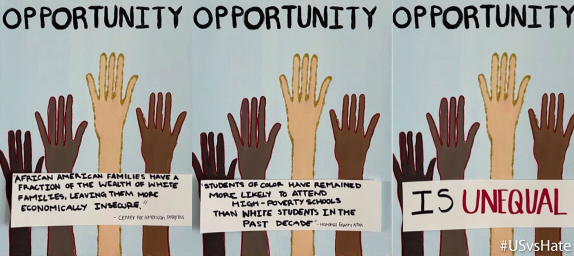
Anessa Flores, San Diego City College
See above for Professor Christy Ball’s explanation.
Emma Chan, Environmental Systems Ecology, Behavior, and Evolution,
UC San Diego
“Shortly after the killings of Ahmaud Arbery, Breonna Taylor, George Floyd, and several other Black people this past year, I read several explanations of the difference between being ‘not racist’ and ‘anti racist’ that various anti-racism advocates published online. Many of these explanations stated that people who described themselves as ‘not racist’ claimed that they did not see skin color or race. I wanted to create a simple dialogue using a comic strip-like format to explain that not seeing color is not an option for people of color because they are overtly and covertly treated differently based on their outward appearances and systemic inequities. The experiences that the characters described were based on issues that I learned about in my EDS 117 class. The characters are diverse, and I wanted to communicate that we are stronger as a society when we embrace diversity and amplify marginalized voices. I also wanted to communicate that people can change and grow. The character who believes in the beginning that she is not racist because she does not see color realizes that she should listen to people of color and work with them to promote anti racism by the end. When writing the dialogue, I wanted to ensure that I was not promoting a ‘White savior’ mentality, so this character acknowledges her mistakes and privilege, and the piece centers the voices of people of color. I hope that viewers understand that the last box is not the end of the story. It is the beginning of long term efforts to practice anti racism in education and elsewhere.”
Betty Velasco, San Diego City College
“The intentions behind this poem are quite personal to me. This is something I experience with my mother. She was faced with a decision that, as I made clear in the poem, was extremely impossible. I would like it if people that weren’t aware before are now aware about one of the things that we are forced to face. Of course, there are numerous things people go through, but I felt like the only way to bring some realness to my poem. I had to make it personal.”
See above for Professor Christy Ball’s explanation.



